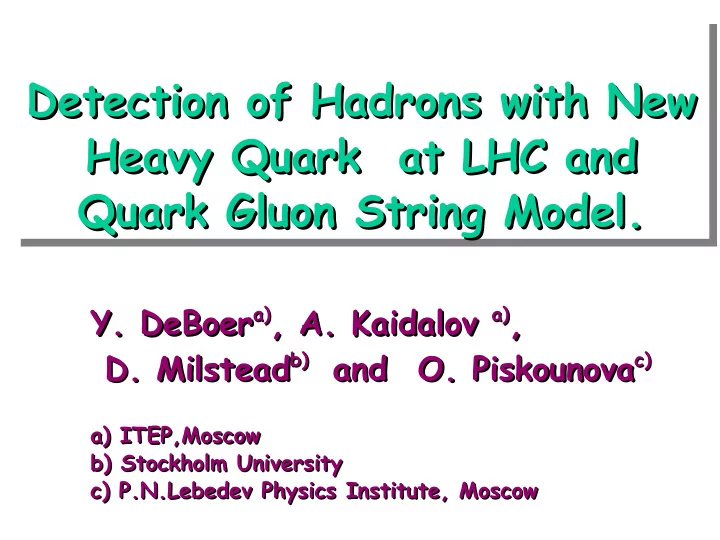

Detection of Hadrons with New Detection of Hadrons with New Heavy Quark at LHC and Heavy Quark at LHC and Quark Gluon String Model. Quark Gluon String Model. Y. DeBoer a) , A. Kaidalov a) , a) , A. Kaidalov a) , Y. DeBoer D. Milstead D. Milstead b) and O. Piskounova c) b) and O. Piskounova c) a) ITEP,Moscow a) ITEP,Moscow b) Stockholm University b) Stockholm University c) P.N.Lebedev Physics Institute, Moscow c) P.N.Lebedev Physics Institute, Moscow
Outline Introduction SUSY definitions Quark Gluon String Model Conditions of experiment Interactions with proton Cross sections Distributions after scattering RRR, RRP, PPR and PPP contributions Average energy losses Results of MC simulations Summary 4/29/08 2 Olga Piskounova
Introduction ● about SUSY models : ● conventional SUSY models (neutralino LSP, masses ~ 1TeV, dark matter > no color, no charge) ● Split SUSY (gluino LSP of very small relic density) ● models with universal extra dimensions (squarks and gluino are effectively stable, masses > 100GeV) ● Compressed SUSY model (S.Martin) predicts quasystable stop quark with low mass > 200 GeV 4/29/08 3 Olga Piskounova
Introduction Previous works: 4/29/08 4 Olga Piskounova
Introduction Quark Gluon String Model knows everything about hadron interactions: ● it considers very high energies ● it gives cross section for the interactions of various quark (antiquark) systems ● it provides the calculations for differential distributions of particles after collision 4/29/08 5 Olga Piskounova
Conditions of experiment I. Search strategy: to collect the time-of-flight in muon chambers information in order to isolate slow-moving-muon-like tracks II. Charge changing interactions: charged particle can anyhow pass into neutral one and back due to hadronic interactions, but can not change the charge from + to - 4/29/08 Olga Piskounova 6
Interaction in particle representation Two particle interactions can be presented as the exchange with Regge trajectory with angle momenta α i (t) 4/29/08 7 Olga Piskounova
Interactions in quark representation Planar diagram for Cylinder diagram for reggeon exchange . pomeron exchanges 8 4/29/08 Olga Piskounova
Cross sections 4/29/08 Olga Piskounova 9
Cross sections in QGSM γ = E/M H Cross section depends only on energy that is left for light quark Pomeron cross section corresponds to γ ∆ , where ∆ P = α P (0)-1= 0.12 10 4/29/08 Olga Piskounova
Distributions after scattering Differential cross sections are derived from x F close to 1 three reggeon asymptotics like RRR, RRP, PPR, PPP. Olga Piskounova 4/29/08 11
Rapidity distributions in R-hadron scattering 4/29/08 12 Olga Piskounova
RRR, RRP, PPR and PPP contributions ● only RRR and RRP terms are coming into energy losses because of small contributions from pomeron terms, PPP and PPR, that correspond to diffraction dissociation of proton. 4/29/08 13 Olga Piskounova
Average energy losses The energy loss in each hadronic collision with the single nucleon target: ● Olga Piskounova 4/29/08 14
Comparison of energy losses In the region of effective γ 's both contributions are similar. It gives the same energy losses for reggeon and pomeron types of contribution. Olga Piskounova 4/29/08 15
MC simulation of interactions the difference in the number of interactions of heavy quark hadrons and heavy antiquark hadrons is clearly seen 4/29/08 16 Olga Piskounova
Summary Summary Hadronic systems with one exotic quark behave rather specifically. Their interactions with ordinary matter was considered in QGSM with the following conclusions: ● cross sections for the scattering of squark exotic hadrons (mesinos) on protons of matter is not large because of new quantum number that can not annihilate. It is bigger than X- section of antisquark mesino due to the valuable possibility of light antiquark to interact with quarks of proton; ● energy losses in matter in case of stop hadrons (RRR) differ not very much from antistop hadron losses (RRP). Hadrons lose 10% of energy in an interaction; ● the number of interactions of heavy quark hadron in hadron calorimeter is much larger than of antiquark hadron, that allows to separate antimater from matter; Olga Piskounova Olga Piskounova 4/29/08 4/29/08 17 17
Summary ● recharge for stop hadrons is possible only by +-1 in hadron interaction, such a way the valuable asymmetry between stop and antistop hadrons is retained though the hadronic calorimeter; ● in muon tracking system we could measure this asymmetry as well as the particular spectra of heavy exotic hadrons ● first publication => arXiv :0710.3930 4/29/08 Olga Piskounova 18
Заключение Адроны с тяжелым суперсимметричным кварком проявляют себя во взаимодействиях с веществом весьма специфически. Моделирование с помощью МКГС прохождения такой частицы через вещество, привело к следующим выводам: ● в области эффективных � сечения взаимодействия с протонами вещества различаются так, что адроны с кварком взаимодействуют чаще, чем адроны содержащие тяжелый антикварк; ● средние потери энергии в этих двух случаях различаются незначительно; Olga Piskounova 4/29/08 19
Заключение ● так как перезарядка адрона во взаимодействии возможна лишь на +-1, в адронном калориметре сохраняется асимметрия между спектрами скварковых и антискварковых адронов; ● мы можем предсказывать зарядовую асимметрию и спектры суперсимметричных адронов, измеряемые в мюонных детекторах. Olga Piskounova 4/29/08 20
Recommend
More recommend